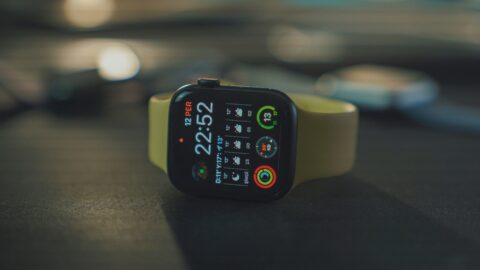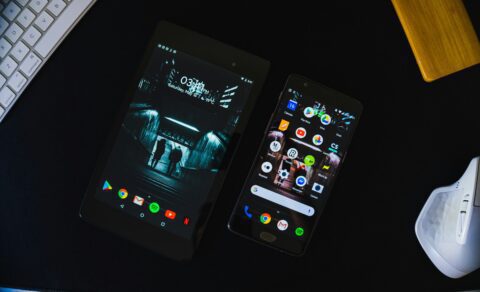Welcome to the digital age, where smartphones and smartwatches have become an indispensable part of our lives. These sleek and innovative devices have revolutionized the way we communicate, stay connected, and even manage our health and fitness. Gone are the days of bulky landline phones and wristwatches that simply told time. Today, we dive into the incredible impact that smartphones and watches have had on our daily routines, social interactions, and overall well-being. So grab your smartphone or glance at your wristwatch – because this blog post is about to take you on a thrilling journey through the world of technology!
The Evolution of Communication Devices
Communication devices have come a long way since the invention of the telephone in 1876. From landline phones to pagers, each advancement has brought us closer to the seamless connection we enjoy today. The evolution of communication devices can be traced through various milestones.
The advent of mobile phones in the 1980s marked a significant shift in how we communicate on the go. These early mobile devices were bulky and had limited functionality compared to our sleek smartphones today. However, they laid the foundation for what was yet to come.
Then came the era of flip phones and text messaging, allowing users to send short messages quickly and conveniently. This opened up new avenues for communication, enabling people to stay connected even without making phone calls.
With advancements in technology, smartphones emerged as game-changers in the late 2000s. Combining telephony with internet capabilities, these pocket-sized powerhouses transformed our lives by offering an array of features beyond simple communication – web browsing, email access, social media integration – all at our fingertips.
Simultaneously, wristwatches evolved from mere timekeeping devices into sophisticated smartwatches that could sync with our smartphones and perform a multitude of tasks beyond telling time. These wearable gadgets became an extension of ourselves – providing notifications, tracking fitness data, and even monitoring heart rates.
The journey from traditional landline phones and basic watches to smartphones and smartwatches demonstrates how far we’ve come in terms of connectivity and convenience. We now live in a world where staying connected is not just about making calls but rather about having information readily available at any given moment – all thanks to these incredible advancements!
The Rise of Smartphones and Watches
The Rise of Smartphones and Watches
Over the past decade, smartphones and watches have become an integral part of our lives. These devices have revolutionized the way we communicate, access information, and stay connected with others. The convenience they offer has made them indispensable tools in our daily routines.
Smartphones have evolved from simple communication devices to powerful mini-computers that fit in the palm of our hand. With their vast array of features and apps, we can do almost anything – from sending emails and browsing the internet to streaming videos and playing games. The rise of app stores has allowed us to customize our phones according to our needs, making them personalized digital assistants.
Similarly, smartwatches have gained popularity as wearable technology that blends style with functionality. They not only tell time but also serve as fitness trackers, music players, and even payment devices. With just a flick of your wrist, you can check notifications or control your smart home appliances without reaching for your phone.
These advancements in technology have significantly impacted various aspects of our lives. Communication has become faster and more accessible than ever before. We can instantly connect with friends across continents through video calls or share updates on social media platforms.
Additionally, smartphones and watches have transformed how we interact socially. Instead of engaging in face-to-face conversations exclusively, we now rely heavily on messaging apps for quick exchanges throughout the day. While this may seem impersonal at times, it allows us to maintain connections with people who are physically far away.
Moreover, these gadgets have spurred innovations in health monitoring by integrating sensors for tracking physical activity levels or heart rate measurements into wearables like smartwatches or fitness bands. This real-time data empowers individuals to take charge of their well-being by setting goals and monitoring progress towards achieving a healthier lifestyle.
However revolutionary these devices may be; they do come with potential drawbacks too – such as addiction or privacy concerns related to constant connectivity online services trackings. It is important to be mindful of our usage and find a healthy balance between
How They Have Changed Our Daily Lives
The impact of smartphones and watches on our daily lives cannot be overstated. These devices have revolutionized the way we live, making tasks easier, communication quicker, and information more readily available.
One significant change brought about by these gadgets is increased accessibility and convenience. With a smartphone or watch at hand, we can now access the internet anytime and anywhere. Whether it’s checking emails during a commute or ordering groceries while waiting in line, these devices have made life more convenient than ever before.
Moreover, smartphones and smartwatches have transformed our social interactions. Instead of relying solely on face-to-face conversations or landline phones, we can now connect with friends and family through various messaging apps and social media platforms. It has become easier to stay connected despite physical distances.
Another remarkable development is the advancements in health and fitness tracking that come with these devices. Smartwatches equipped with heart rate monitors, step counters, sleep trackers, and other features allow us to monitor our health effortlessly. They encourage healthier habits by providing real-time feedback on our activity levels.
However, it’s important to acknowledge that there are potential drawbacks associated with this technology as well. Excessive use of smartphones can lead to addiction or dependence on virtual connections rather than fostering meaningful relationships in person. Additionally, constant notifications from these devices may contribute to feelings of anxiety or distraction from important tasks.
Nonetheless, solutions exist for mitigating such issues. Implementing screen time limits or engaging in regular digital detoxes can help maintain a healthier balance between technology use and personal interactions. Being aware of one’s device usage habits is crucial for ensuring a positive impact on daily life.
Looking ahead into the future possibilities offered by smartphone and watch technology is exciting! With ongoing advancements such as augmented reality integration or even foldable screens becoming common features in smartphones today – who knows what wonders await us tomorrow?
In conclusion (sorry!) – smartphones and watches have undoubtedly changed our daily lives significantly over the years. They have made our lives more convenient, facilitated social interactions, and
Increased Accessibility and Convenience
Smartphones and watches have revolutionized the way we live in countless ways. One of the most significant changes they’ve brought about is increased accessibility and convenience. Gone are the days when we had to rely on landline telephones or bulky computers to stay connected.
With smartphones, we now have instant access to a world of information right at our fingertips. We can easily check emails, browse social media, stream videos, and even shop online wherever we are. The convenience of having all these capabilities in one compact device is truly remarkable.
Not only that, but smartphones also enable us to stay connected with loved ones no matter where they are in the world. With just a few taps on our screens, we can make video calls or send messages instantly. No longer do distance and time zones pose barriers to staying in touch with friends and family.
Watches have also played their part in enhancing accessibility and convenience. With smartwatches strapped to our wrists, we can receive notifications for calls, messages, emails, and calendar events without having to constantly reach for our phones. This hands-free approach allows us to multitask more efficiently throughout the day.
Furthermore, smartwatches often come equipped with built-in GPS functionality which makes navigation easier than ever before. Whether you’re exploring a new city or going for a run in unfamiliar territory, you can rely on your watch to guide you accurately without needing an additional device.
The increased accessibility and convenience offered by smartphones and watches have undoubtedly made our lives more efficient and streamlined. However,it’s important not be overly reliant on these devices as it can lead to decreased human interaction or overdependence on technology.
As technology continues advancing at lightning speed,the possibilities for future smartphone and watch developments are both excitingand endless.
The potential applicationsof augmented reality,virtual reality,and artificial intelligencein these devicescan open up entirely new realms of possibility.
Whilewe must navigate any drawbacks responsibly,the overall impactofthese technological advancementsis undoubtedly transformative. So, let’s embrace the accessibility and convenience offered by smartphones and
Impact on Social Interactions
Impact on Social Interactions:
The rise of smartphones and watches has undoubtedly changed the way we interact with one another. These devices have become an integral part of our daily lives, allowing us to stay connected at all times. With just a few taps on a screen or a glance at our wrist, we can communicate with friends and family, share moments through social media platforms, and even meet new people through dating apps.
However, as convenient as these devices may be, they have also had some unintended consequences on our social interactions. It’s not uncommon to see groups of friends sitting together but engrossed in their individual screens rather than engaging in face-to-face conversations. Our attention is often divided between the physical world around us and the virtual world inside our phones.
Moreover, constant notifications from social media apps can create a sense of urgency that compels us to constantly check our phones for updates. This can lead to feelings of anxiety or FOMO (fear of missing out) if we are unable to keep up with the fast-paced digital world.
On the positive side, smartphones and watches have made it easier for individuals who struggle with traditional forms of communication due to disabilities or shyness. Text messaging allows them to express themselves more comfortably without feeling overwhelmed by direct interaction.
Another significant impact is seen in long-distance relationships where smartphones enable couples separated by distance to bridge that gap by staying connected through video calls and instant messaging apps.
While smartphones and watches have revolutionized how we connect with others on both personal and professional levels, it’s important for us to find a balance between utilizing these technologies for convenience while still prioritizing genuine human connection.
Advancements in Health and Fitness Tracking
Advancements in Health and Fitness Tracking have revolutionized the way we approach our well-being. With smartphones and watches equipped with sensors and apps specifically designed for tracking our health, it has become easier than ever to monitor various aspects of our physical fitness.
These devices allow us to track metrics such as steps taken, distance traveled, calories burned, heart rate, and even sleep patterns. By having access to this information at our fingertips (or on our wrists), we can make informed decisions about diet, exercise routines, and overall lifestyle choices.
One of the greatest benefits of health tracking technology is its ability to motivate us to stay active. Seeing concrete data about how much we’ve moved or how many calories we’ve burned can be a powerful motivator. It encourages us to set goals and challenge ourselves to reach new levels of fitness.
Additionally, these devices often offer features like reminders or notifications that prompt us to engage in healthy behaviors throughout the day. Whether it’s reminding us to take breaks from sitting or encouraging us to drink more water, these gentle nudges help keep wellness top-of-mind.
The integration of social connectivity within health tracking apps also plays a significant role in motivating individuals towards their fitness goals. Sharing achievements with friends or joining virtual communities focused on specific activities creates a sense of camaraderie and friendly competition that keeps users engaged.
Furthermore, advancements in health tracking have paved the way for personalized insights into individual wellness trends over time. By collecting long-term data about our activity levels and vital signs, these technologies enable us not only to identify patterns but also provide valuable feedback regarding potential areas for improvement.
Although there are potential drawbacks associated with relying too heavily on wearable technology for health monitoring — such as becoming overly dependent on device-generated recommendations – solutions are being developed continuously by manufacturers through improved algorithms that refine accuracy while reducing false positives/negatives when measuring biometric data.
As smartphone technology continues advancing exponentially year after year alongside developments in wearable devices, the future possibilities for health and fitness tracking are exciting. We can
Potential Drawbacks and Solutions
Potential Drawbacks and Solutions:
While smartphones and watches have undoubtedly revolutionized the way we live, they are not without their drawbacks. One of the major concerns is the potential for addiction. With constant access to social media, games, and other addictive apps, it’s easy to get sucked into a digital vortex that can be hard to escape from.
Another drawback is the impact on our mental health. Studies have shown that excessive smartphone use can lead to increased levels of anxiety and depression. The constant need for validation through likes and comments on social media platforms can also negatively affect self-esteem.
In addition to these psychological issues, there are also physical implications. Spending hours hunched over a smartphone or watch screen can lead to poor posture and neck strain. Eye strain from staring at screens for prolonged periods is another common issue.
To address these drawbacks, it’s important to set boundaries with our devices. Limiting screen time, especially before bed, can help improve sleep quality and reduce dependency on technology. Engaging in offline activities such as hobbies or spending time with loved ones can also provide a healthy balance.
Practicing mindfulness techniques like meditation or taking regular breaks from screens throughout the day can help alleviate stress and promote mental well-being. It’s also important to prioritize self-care by exercising regularly, maintaining good posture while using devices, and giving our eyes regular breaks by looking away from screens every 20 minutes or so.
While smartphones and watches have certainly transformed our lives in many positive ways, it’s crucial that we remain aware of their potential negative impacts on our well-being – both physically and mentally – so that we can enjoy all their benefits without falling victim to their downsides.
Future Possibilities of Smartphone and Watch Technology
The future of smartphone and watch technology holds endless possibilities. As we continue to push the boundaries of innovation, these devices will likely become even more integrated into our daily lives.
One exciting area of development is in augmented reality (AR) and virtual reality (VR). Imagine being able to use your smartphone or smartwatch to project holograms or immerse yourself in a virtual world with just a few taps on the screen. This could revolutionize entertainment, gaming, education, and even professional industries like architecture and design.
Another area that shows promise is artificial intelligence (AI) integration. Smartphones and watches equipped with AI assistants can already perform tasks such as voice commands, language translation, and personalized recommendations. In the future, we may see AI becoming smarter and more intuitive, allowing us to interact with our devices in even more natural ways.
Additionally, advancements in biometric technology are paving the way for enhanced security features on smartphones and watches. Facial recognition, fingerprint scanning, or even iris scanning could soon become standard methods for unlocking our devices or authorizing transactions.
Furthermore, there is ongoing research into new materials that can be used to make screens flexible and foldable. This means that smartphones may one day have displays that can be rolled up like a scroll or unfolded into larger screens for enhanced productivity.
Continued improvements in battery life will address one of the major limitations of current smartphones and watches. With longer-lasting batteries or innovative charging solutions like wireless charging at a distance or solar-powered options,
It’s clear that smartphones and watches have already had a significant impact on how we live our lives today. But their potential goes far beyond what we currently see before us. The future possibilities are truly limitless—bringing together convenience, connectivity,
and cutting-edge technology.







